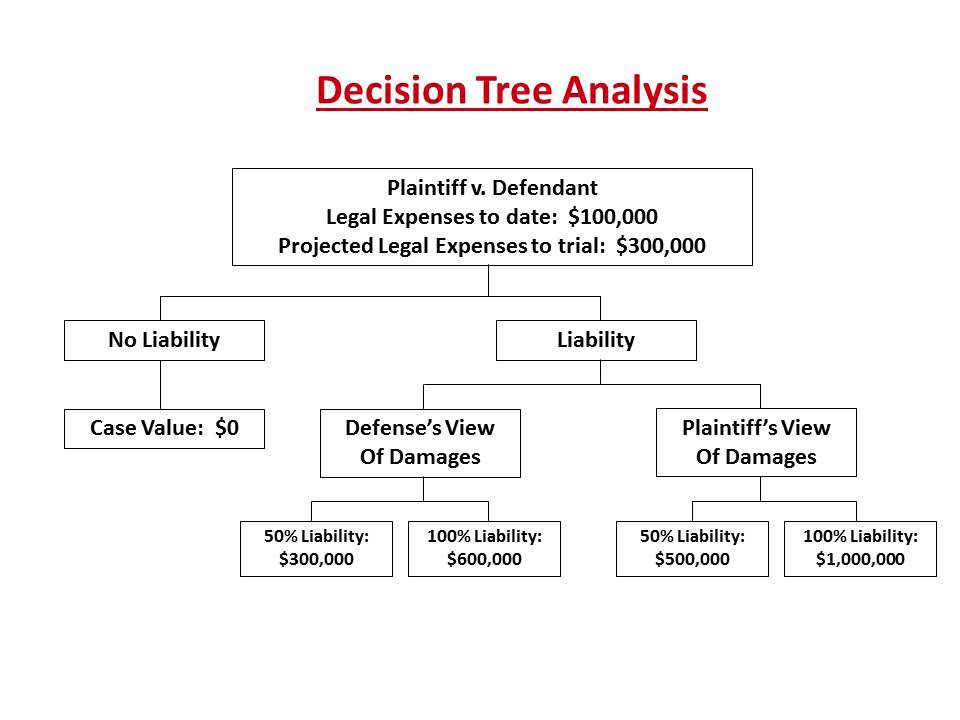Decision Tree Analysis of Personal Injury Cases

Many variables affect the evaluation of a personal injury case. You may prevail on some issues, but not on others. Because you must consider a variety of trial outcomes, you will need to develop a range of values. One way to do this is by decision tree analysis.
A decision tree is a graphic illustration of various possible outcomes. For each issue, there should be a branch going one way for a positive result and the other way for a negative result. This process can get complex, but don’t overthink it. There are rarely more than five crucial issues in any case.
Here is a simplified decision tree:

If the plaintiff cannot prove liability, the case has no value. Often, questions of comparative fault can arise. Was plaintiff partially responsible for this outcome? Perhaps there are other entities to which responsibility can be assigned who may not even be part of the lawsuit. In the illustrated case, if the plaintiff can prevail on liability and show the defendant bears all responsibility, plaintiff can expect a valuation of a million dollars.
But what if the jury believes that the plaintiff or someone else bears some responsibility? What if the parties disagree about the calculation of the damages? Based on a review of the facts and the different positions parties have taken in the history of the litigation, you can define those areas and assign a value for each outcome. You come up with that value using the methods described in the prior chapters.
Inevitably, you are more likely to prevail on some issues than others. This decision tree shows five possible outcomes. But do they each have a one-in-five likelihood? You can produce a better evaluation tool by weighting which outcomes are the most likely. Here is a simplified weighted decision tree analysis for the same case.

Now we have a better guide to making a settlement decision. Litigators frequently ponder, “If you tried this case ten times, how many times would you get your best possible outcome?” This chart shows the estimates for a specified result.
One time out of ten, the defendant will win, and the plaintiff will get nothing. This result is called a “take nothing” or that the case was “defended.” Three times out of ten the plaintiff is projected to show full liability, but in only half of those cases will plaintiff be able to prove up damages sufficiently. According to this chart, the most likely result is that plaintiff will be able to show the defendant is 50% responsible.
Settlement Statement Shows the Net Result
A settlement statement is a document plaintiff’s attorney prepares to demonstrate how the money received from the defendant is being allocated and the remaining amount the plaintiff will receive. At the time of this evaluation, $100,000 has been spent to prepare the case. If plaintiff accepts a $300,000 settlement today, the likely settlement statement will look like this:
| Attorney Fees (1/3) | $100,000.00 |
| Legal Expenses | $100,000.00 |
| Net to Plaintiff | $100,000.00 |
| $300,000.00 |
Going to trial is expensive. Each side must pay to prepare exhibits and for experts’ time. Here plaintiff’s legal expenses to go to trial are estimated at $300,000. If the plaintiff obtains the higher likely result of $500,000, the settlement statement will look like this:
| Attorney Fees (1/3) | $166,666.66 |
| Legal Expenses | $300,000.00 |
| Net to Plaintiff | $ 33,333.34 |
| $500,000.00 |
In this scenario, plaintiff would be better off negotiating a settlement of at least $300, 000, which would still be a bargain for the defendant. Not only would the defendant end up paying at the low end of the possible verdict range, but defendant would also be avoiding its expense of a trial, probably also about $300,000. This deal would be what’s known as a “win-win” settlement.
Is there a chance that plaintiff will be entirely successful and get the full million dollars? Sure, but your evaluation tells you that the chance of that result is only 15%. If a settlement offer comes within the zone of the most likely outcome, are you willing to throw it away and possibly become indebted for additional legal expenses on a 15% chance of success?
If you do have a favorable settlement, what will usually occur then is the payment to you will be done through a structured settlement. Doing so is for not only your benefit but for the interest of the insurance company or defendant. Usually, agreeing to a structured settlement will give you a higher settlement figure since you agree to accept the payments over time, instead of with a lump sum. Of course, your attorney will give a recommendation, but often attornies have deals worked out with settlement companies which may not be in your best interest.
Do your homework first as you hired an expert attorney to represent you and you also want an expert serving you for the structured settlement you are about to receive.
Decision tree analysis can help you make better rational decisions about how to negotiate an agreement.…
